Want to keep your Pothos alive? Proper watering is key! Here’s how often to water pothos plants!
One of the simplest indoor plants to care for is the pothos.
Its popular name derives from the genus Pothos aureus, and in addition to the traditional jade-green Pothos, there are a few more varieties. Examples include the Pothos Marble Queen, which has darker green and white variegation, and the Golden Pothos, distinguished by its heart-shaped green leaves with yellow variegation.
The Pothos is especially suited for interior environments since it can remove gaseous pollutants like formaldehyde from the air.
It is also a climber! It is well renowned for outgrowing tree trunks and forest floors in its native Southeast Asia as a result of its aerial root structure.
Under ideal indoor circumstances, it may trail up to 10 feet long and produce four to eight inches of leaves.
Now that you are familiar with the basics let’s go deeper into details. Let’s talk about Pothos watering schedule!
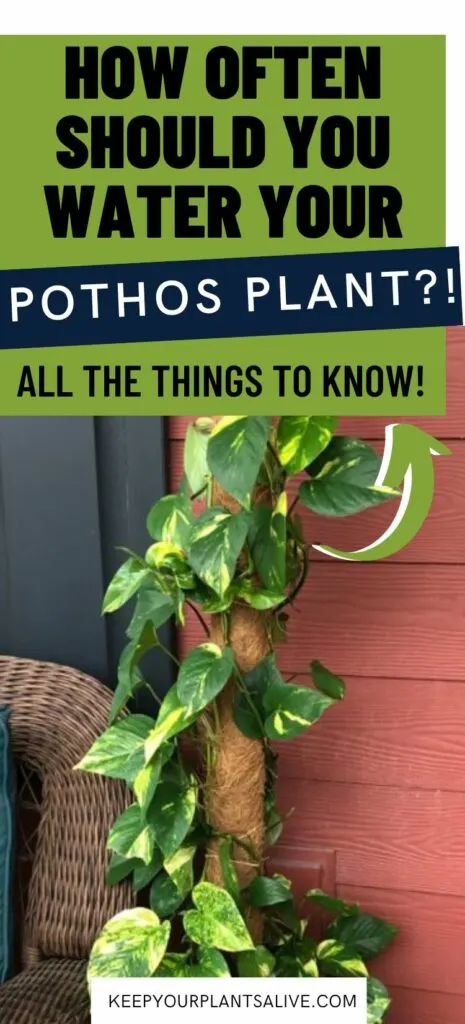
Other pothos content you might enjoy:
- Golden pothos care guide
- Cebu Blue pothos care guide
- Baltic Blue pothos care guide
- Marble Queen pothos care guide
- Global Green pothos care guide
- Neon pothos care guide
- NJoy Pothos Care Guide
- Why are my pothos leaves turning yellow?
- Why are my pothos leaves turning brown?
- Why is my pothos plant not growing leaves?
- Why are my pothos cuttings rotting
- How to move pothos from water to soil
- Should I mist my pothos?
- How to make pothos fuller
- Can you propagate pothos without a leaf?
- Can you propagate pothos from a leaf?
- Can you propagate a long pothos vine?
- Where to cut pothos for propagation
- Pothos vs Snake plants: which is better for beginners?
- Cebu Blue Pothos vs Baltic Blue Pothos
- How to propagate pothos
- How to propagate golden pothos
- How to propagate a satin pothos
- How to propagate pothos in soil
- How often to water pothos plants
- How to care for variegated pothos
- How to revive a dying pothos plant
- Why are my Pothos leaves curling?
- How to identify and treat common pothos pests
- How to divide pothos plant
- How to make pothos grow bigger leaves
- Why does my pothos only have one vine?
- Can you grow pothos in low light conditions?
- How to cut off dead pothos leaves
- Are pothos plants toxic to cats and dogs?
- Can you grow pothos in water?
- Why is my pothos droopy?
- Why is my pothos plant dropping leaves?
Printable Pothos Plant Care Guide
Join the (free!) KeepYourPlantsAlive+ community to access this exclusive printable plant care guide! Or keep scrolling for more!
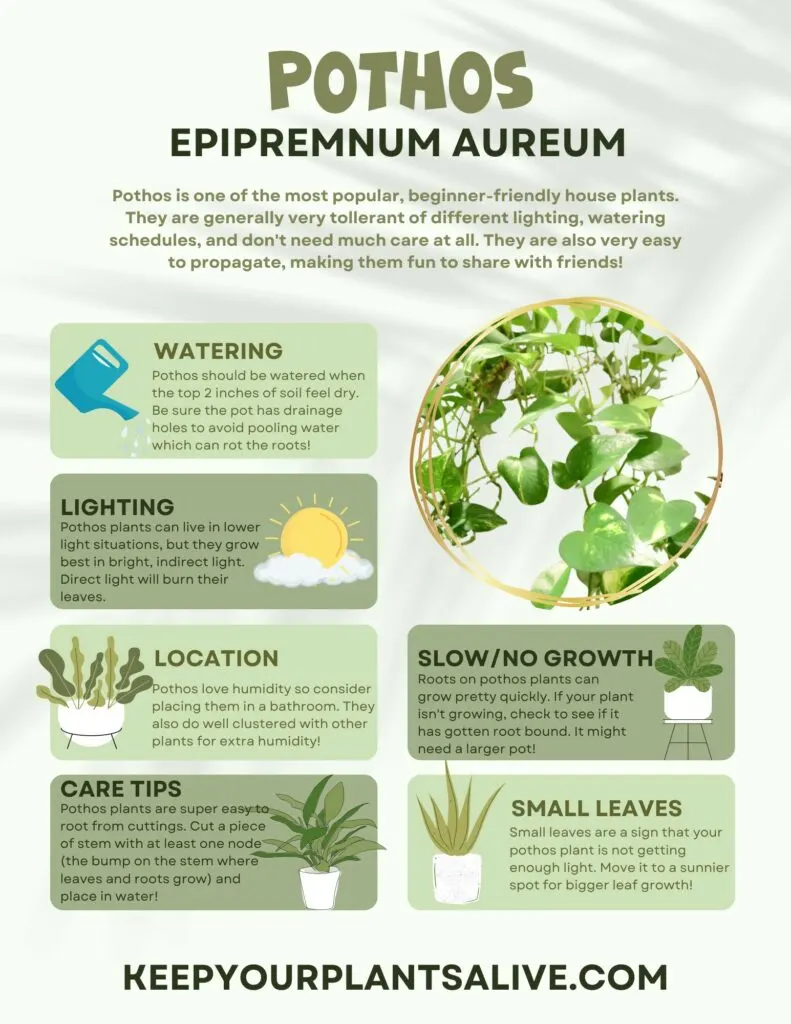
How often should you water your pothos?
Generally, you want to water your pothos when the top 2 inches of soil feel dry to the touch. This amounts to about once a week in the summer and every week and a half in cooler months.
Even for indoor plants, seasons have an impact on how quickly pothos develop and, consequently, how much water they require.
A pothos’ usual growth season runs from spring through October. Throughout this period, your pothos may grow several feet and perhaps produce 15 to 30 new leaves. Isn’t it amazing?
Your irrigation practices must keep pace with this rapid expansion. The moisture content of the soil should be the main concern.
Establish a routine of examining the plant once a week to see if the soil is dry to the touch or if it has been too long since you last watered.
Another piece of information is that watering should differ in summer and winter. Here are the differences.
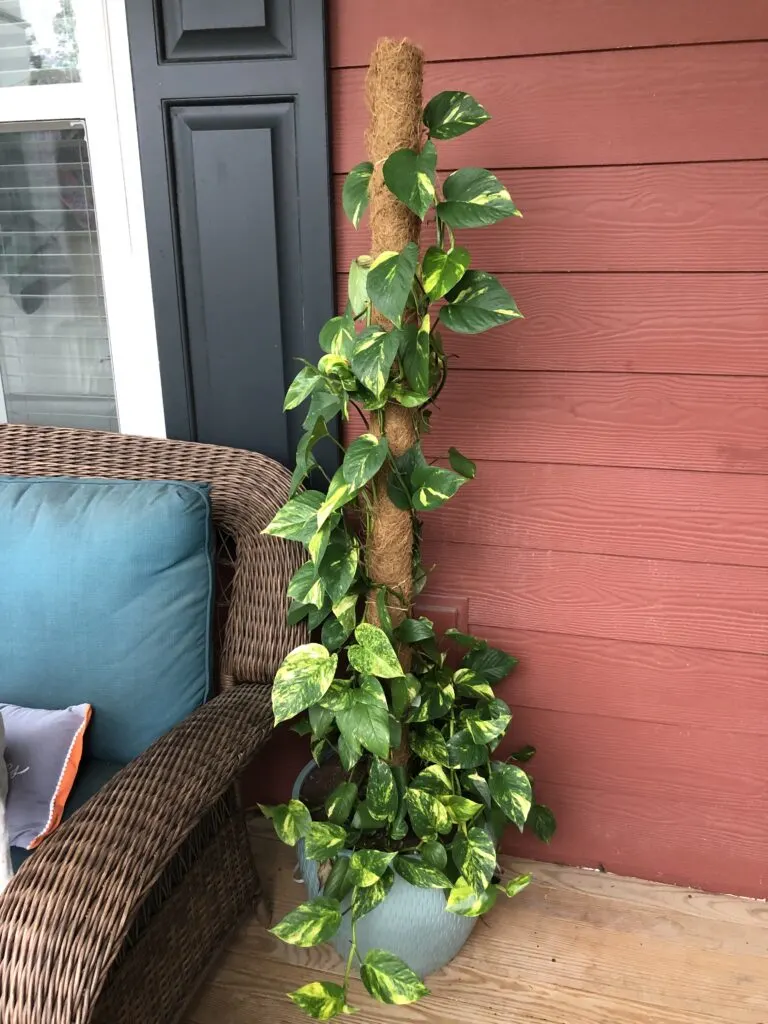
During winter months
Fall and winter are the dormant seasons for most plants, including pothos, which distinctly slows their development.
As nutrient intake is minimal at this time, fertilizing your pothos is not essential. Maintain the ideal temperature range of 65–70° F at night and 75–90° F during the day for indoor pothos plants.
Pothos isn’t very needy, therefore, it will flourish in most indoor environments with temperatures over 50 °F.
Furthermore, your pothos will need less water while dormant. This does not imply that a little additional water would be advantageous.
We’ll say it again: giving your pothos extra water during dormancy won’t make them love you more. On the contrary, it may have an adverse effect.
The majority of pothos don’t appreciate soil that is always moist, mainly due to its short roots. In contrast, they like the soil to get dry between waterings.
Before rehydrating the soil, water it lightly all around the pot. During this period, your pothos should show little sign of life; just have faith that the development cycle is at work!
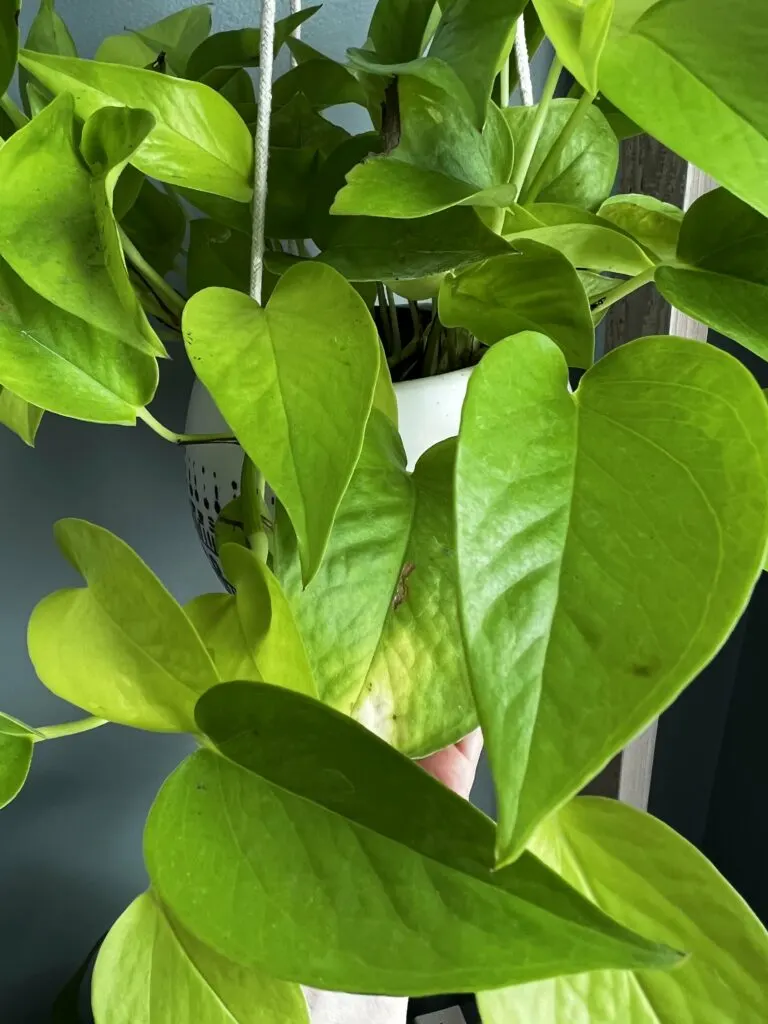
During summer months
The best time of year for pothos to flourish is in the summer. Water your pothos 2-3 times more during these hotter months than you do during dormancy.
The most crucial thing to do is measure the moisture level of your pothos’ soil twice a week, especially before each watering.
Under the hot summer heat, the plant will absorb more water and dry out more rapidly, so be cautious!
How much water does a pothos need?
Now that we have covered the question of how often you should water your pothos, let’s continue with more information about water necessities.
The good news is that your pothos will probably recover fast if you neglect to water it or slightly overwater it. That doesn’t mean you shouldn’t keep up with a well-organized pothos watering schedule.
When properly hydrated, your pothos will maintain their healthiest appearance. As previously noted, allowing your pothos’ soil completely dry out between waterings is a good idea.
Stick your finger down or use a soil probe to determine whether the soil is dry. Your plant is prepared for some water if the soil probe reads 2-3.
Using a watering bucket or jug, carefully pour the water over the soil until you see water draining out of the drainage holes at the bottom of the pot.
Be sure to drain any excess water that may have poured onto the saucer, so your pothos isn’t sitting in it.
If you are unsure whether you are overwatering or underwatering it, here are some signs to look after.
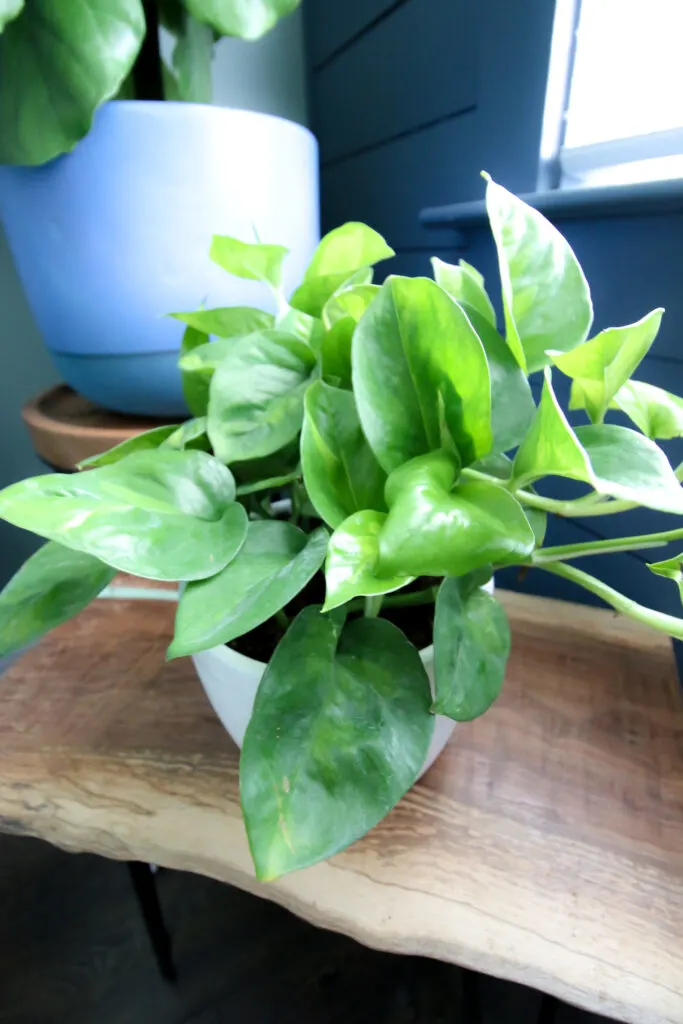
Signs of pothos being overwatered
If you constantly give your pothos too much water or let the plant stay in moist soil for an extended time, you may be encouraging a wide range of issues, such as mold and root rot, to attack your green companion.
Look for these indications of an overwatered pothos plant on the leaves and roots of the plant:
- Brown stains on leaves
- The soil’s surface is covered in mold.
- Mushy, shriveled leaves
- Yellow leaves (don’t get this confused with the leaves of golden variegation)
- Curled, wilting leaves
- Root decay
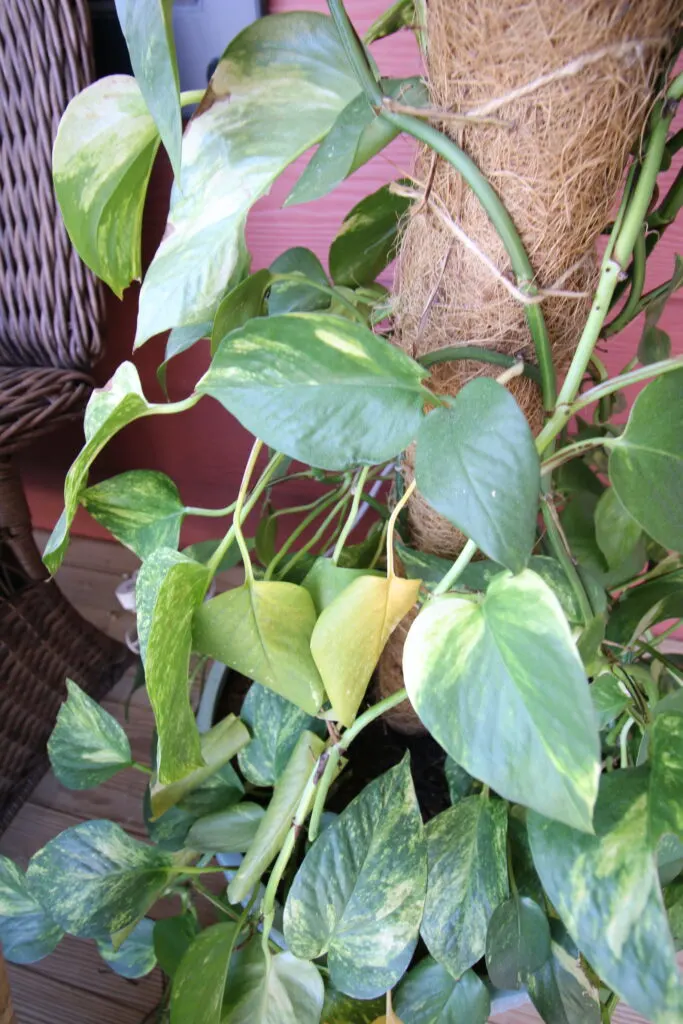
Signs pothos is underwatered
Even though the water requirements are minimal, your verdant buddy will start to suffer if you don’t give your pothos any water for a long time. Ideally, you’ll be able to tell when you’ve neglected your pothos, but if you’ve been away or trusted someone else with its maintenance, here are some warning signs:
- Brown, crumpled leaves
- Wilted foliage
- Reduced plant size
- Creased leaves
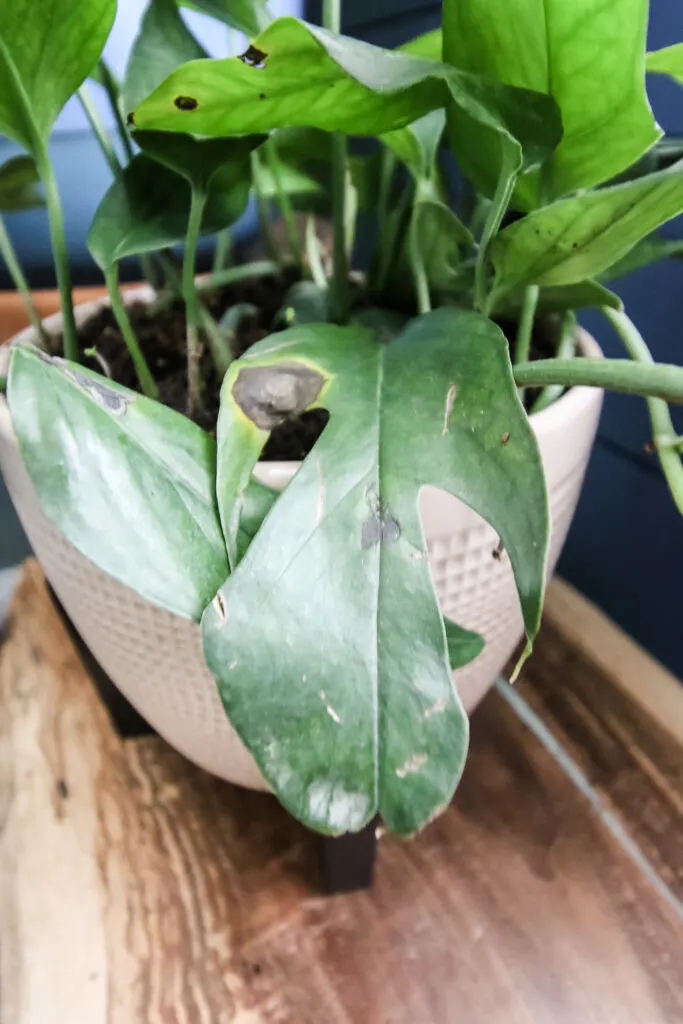
Tips for your pothos
- Most frequently, over or underwatering causes yellowing. If a leaf has both yellow and brown coloring, overwatering is probably to blame. If you notice yellow leaves with some crispy brown spots on other leaves, underwatering may be the cause.
- It is totally normal if your pothos has and brown, string-like growths. These are known as aerial roots and are quite natural. In nature, this aids in supporting the plant and enables it to rise and attain higher levels of light. The roots won’t harm surfaces or walls, and if they start to get out of control, you can always cut them.
- As roots die back from a lack of oxygen, overwatering circumstances can result in root rot. Fungi in the soil that may suddenly grow as a result of overwatering can also cause root rot. Even when the soil is damp, your pothos’ leaves may gradually start to wilt and become yellow. You can also inspect the roots, which may feel soggy and appear brown or black. Do not overwater if you think your plant may have root rot. Remove the plant from the soil and re-pot for best results.
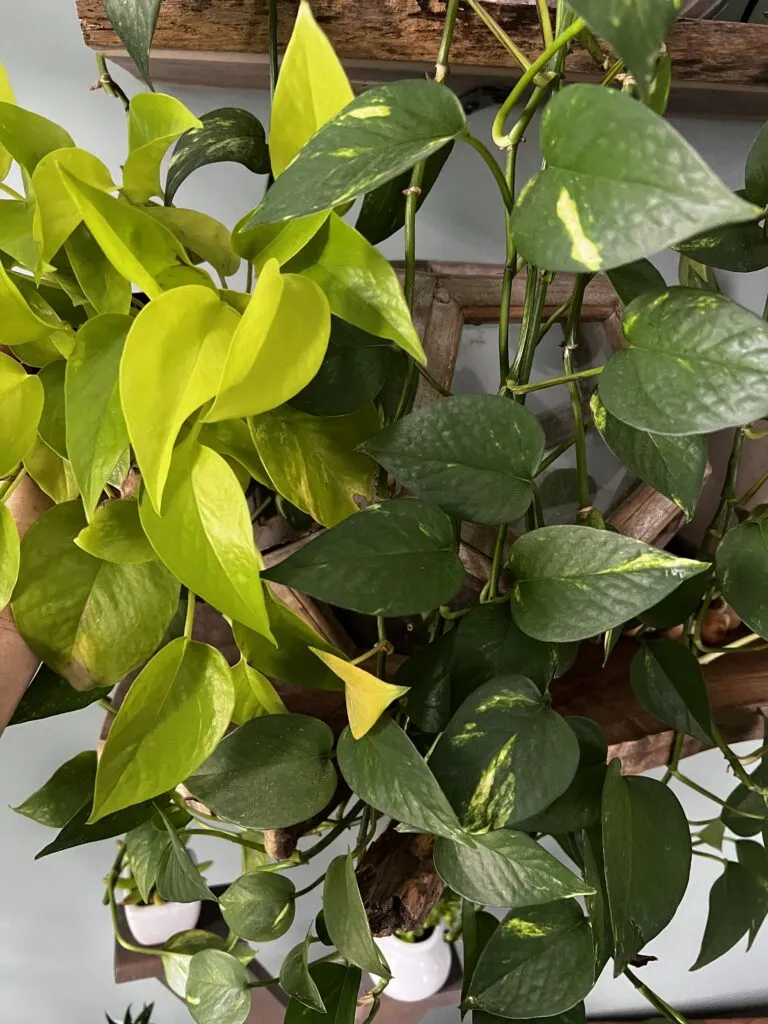
Final thoughts
The Pothos is a low-maintenance plant that is ideal for beginners. As suggested above, a very important thing you need to focus on is how often you should water your pothos.
If you do come across houseplant pests, deal with them as soon as they show up by giving the plant weekly wipe-downs and weekly applications of a natural insecticide like neem oil.
Finally, if you are a plant lover and you want to know more about pothos, be sure to check our free PDF pothos plant care guide!
Printable Pothos Plant Care Guide
Join the (free!) KeepYourPlantsAlive+ community to access this exclusive printable plant care guide! Or keep scrolling for more!

Thanks for reading!


Hey there, I’m Morgan, a houseplant enthusiast from sunny Charleston, South Carolina. Growing up surrounded by my mom’s lush orchids and African violets, I discovered the magic of bringing nature indoors. Thanks to the pandemic, I delved deeper into houseplants, discovering their power to uplift moods and transform spaces. I’m here to spill all my secrets, helping you pick the perfect houseplant – and make it happy. Let’s keep your plants alive, together! 😊
